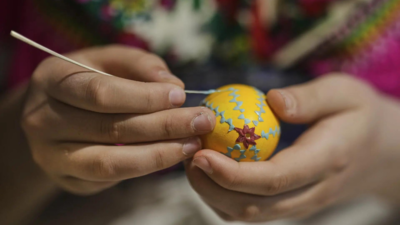Ancient Manuscripts Return to Ireland: A Cultural Reunion after a Millennium

More than a thousand years ago, a group of Irish monks undertook a perilous journey, carrying precious manuscripts across the turbulent waters of the European continent. Their purpose was twofold: to protect these invaluable texts from Viking raids and to further their mission of spreading Christianity and scholarship. This significant act of preservation was a beacon of culture during what is often referred to as the Dark Ages.
At that time, the monks could not predict the fate of the books they safeguarded. Among the manuscripts were religious scriptures, linguistic analyses, a collection of jestful writings, and an assortment of tomes that have been likened to the Internet of the ancient world. They held a wealth of knowledge, but their survival was uncertain as the years passed.
Fast forward to today, and fragments of this remarkable collection are now making their way back home to Ireland for the very first time in centuries. The Abbey of Saint Gall in Switzerland has agreed to lend 17 rare manuscripts to the National Museum of Ireland in Dublin. This landmark exhibition, aptly titled Words on the Wave: Ireland and St Gallen in Early Medieval Europe, aims to recreate the rich cultural tapestry of Irelands golden agethe era of the land of saints and scholars. During this period, missionary monks established flourishing monasteries across what are now Britain, France, Germany, Switzerland, and Italy.
Matthew Seaver, the curator of the exhibition, expressed the intent behind the showcase: What were trying to do is to retrace those journeys and the world in which those manuscripts were produced. These books are key to an understanding of ourselves, our language, and our links with the continent. Their value and importance are difficult to overestimate.
While Ireland has managed to preserve the renowned Book of Kells, a masterpiece currently on display at Trinity College Dublin, it lost the majority of its ancient manuscripts to Viking invasions and the ensuing centuries of political upheaval. According to Seaver, Thats why today there are more Irish manuscripts in Britain and the continent than in Ireland.
This exhibition arrives at a time when the world grapples with challenges to international trade and European unity, serving as a poignant reminder of the economic, cultural, and political ties that have historically linked the Atlantic to the Alps since the fifth century.
Following the widespread conversion of Ireland to Christianity, its monasteries emerged as burgeoning centers of learning. They produced and replicated a wealth of academic and religious manuscripts, including the oldest surviving copy of Etymologiae, an encyclopedia that has been described as the Internet of antiquity.
One of the manuscripts, Priscians Institutiones Grammaticae, contains not just rules of Latin grammar but also comments scribbled by the scribes about their daily lives. One scribe humorously noted his hangover, stating he was ale-killed. Others lamented the cold weather or the quality of their writing materials, with one remarking, New parchment, bad ink. O I say nothing more.
Interestingly, a concerned scribe once penned a poem about the weather, hoping that a storm would deter any Viking incursions: Bitter is the wind tonight, it tosses the oceans white hair: I fear not the coursing of a clear sea by the fierce heroes from Lothlend. These candid comments illustrate that these manuscripts were not merely academic relics but offered a glimpse into the human experience of early medieval Irish monks, showcasing their humor, frustrations, and resilience.
Curator Seaver emphasized that the act of transporting manuscripts to the continent was not merely a defensive measure against the Viking threat but part of a broader cultural exchange. He explained, It was a two-way street. From an early stage, Ireland was receiving books and scholars from the continent and Anglo-Saxon England. Ships that brought essential goods like wine, oils, and pottery from the continent also facilitated these cultural exchanges by transporting Irish monks in the opposite direction.
Saint Columba, also known as Columbanus, stands out as one of the most famous figures from this era. In the seventh century, he established monasteries in the Frankish and Lombard kingdoms, while one of his disciples, Saint Gall, founded a hermitage that eventually evolved into an abbey situated in what is now the Swiss city of St. Gallen.
The library of this abbey, which is recognized as a UNESCO World Heritage site, has consented to lend 17 manuscripts for the exhibition. This much-anticipated event is set to run from May 30 to October 24. Visitors to the National Museum of Ireland will have the unique opportunity to view these texts alongside over 100 artifacts from the museum's collection, including the Lough Kinale Book Shrinethe earliest and largest known container for a sacred text. This artifact, which was discovered in a broken state at the bottom of a Longford lake, will make its public debut in the exhibition following extensive restoration efforts.















